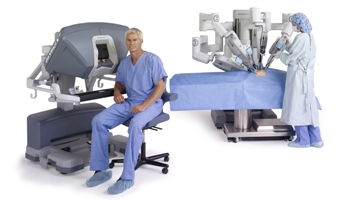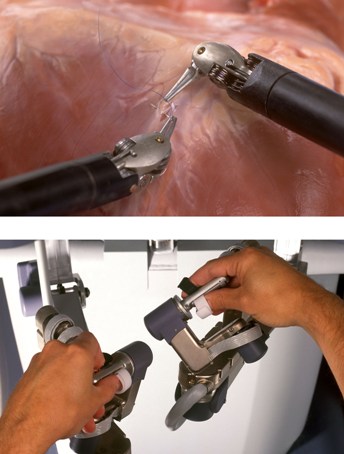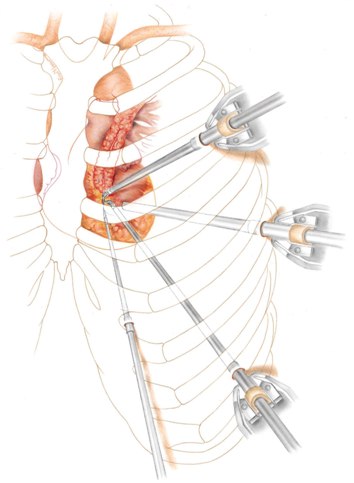the da Vinci robot surgical system
At the beginning let me say something. This article is about the da Vinci robot surgery system made by Intuitive surgical. If you’d like to read about automated devices made by renaissance genius Leonardo da Vinci, please go to my page on that topic.
The da Vinci robot surgery system is a significant breakthrough in medical robotics field. Although relatively recently there was another system of this type – ZEUS robot, as far as I’m aware, the da Vinci system is the only one being actively marketed, sold and used world-wide at the moment.
History

The initial prototype of the da Vinci surgical system was developed in the late 1980s under a contract with the U.S. Army. As you can understand, the army was interested in tele-robotics capabilities of robotic surgery systems. However, the designers found the idea of broadening the possibilities of minimally invasive surgery appealing.
So, the company Intuitive Surgical was founded in 1995. In 1999 they released the da Vinci Surgical system. It was approved for general laparoscopic procedures by the FDA in 2000. Around that time there was a dispute between Intuitive Surgical and their direct competitor Computer Motion that developed a similar robotic assisted surgery solution – ZEUS.
ZEUS has written its name in history because it was used in a surgery dubbed the Lindbergh operation. This was one of the first complete tele-robotics surgeries in history. French surgeons seated in New York performed a gallbladder removal surgery on a patient in France.
The dispute ended when Intuitive Surgical acquired the Computer Motion. Thus all their patents, as well as rights on the ZEUS surgery system, went over to Intuitive Surgical. As Intuitive Surgical focuses on its product, the ZEUS platform is not being sold anymore.
The latest addition to Intuitive Surgical’s product line is the da Vinci Si HD system. It was released in April, 2009.
Operation

I guess at this moment you can be a little bit confused. I’m talking all the time about robotic surgery, robotic surgery systems, et cetera, without giving a slightest nod on what it actually is and how it works. Let me correct this.
One of the most common misconceptions is the level of AI involved. Although I use here the term robotic surgery it may be a bit misplaced. The da Vinci robot surgery system doesn’t do anything on its own. The surgeon controls everything that happens.
From this point of view it is a disputable question whether the da Vinci system can be called a robot as it lacks artificial intelligence. However, this kind of discussions is unnecessary in my opinion. Theoretically the software could be made and all the hardware is there.
As the level of AI needed to perform surgeries on its own is very advanced it is better to leave the thinking to human surgeons. That is exactly what the da Vinci system does – it enables a human surgeon to do things more effectively.
The da Vinci robot surgical system uses the minimally invasive approach. This means that several small incisions are made instead of one large. This way the levels of blood loss, post-surgical trauma, as well as the amount of scar tissue and time spent in hospital are reduced.
Of course, it is not necessary to have a robot to use this method. Still, the da Vinci system takes this approach to an entirely new level. A surgeon seated at the da Vinci system’s surgeon’s console can control the tools at the patient’s side while viewing a 3D image of the operation’s site. This way the hand – eye coordination is preserved.
Basically, it’s like scaling down the surgeon and putting him into patient’s body through a few small incisions. As I said, this approach can be used with tools other than robots, however, robotic system enables a surgeon to control the tools more or less naturally. So it is possible to apply minimally invasive approach to a broader range of surgeries.
To grasp the idea and scale of the operation you can watch the video below where a surgeon from Japan uses the da Vinci robot surgery system to do origami. You can also find videos of actual surgeries on YouTube – just search for “robotic prostatectomy” or “robotic hysterectomy”.
Application
I already mentioned two procedures where the da Vinci robot surgical system is used. As you can understand, this is not limited to them. One of the benefits of this system is that it can be used for different procedures if equipped with suitable tools.
The system is used for various gynecologic, urologic, cardiac, thoracic and other procedures. I won’t count all surgical procedures where the da Vinci system is used because I must admit I have to look them up in dictionary to find the meaning. However, if you are a physician interested in the da Vinci system, search Intuitive Surgical’s site for more precise information.

It is pretty straightforward that a robotic system like this can be used for procedures where the main reason to make large cuts is to provide space for surgeon’s hands. Moreover, it turns out that this approach can be used to aid transplantations as well.
In case of robot aided kidney transplantation the largest incision has to be made to insert the kidney. The minimally invasive approach is then used to complete the procedure. This way the transplantation can be carried out using one larger (approximately 5 cm) incision and a few smaller ones, as in case of minimally invasive approach instead of one large (approximately 15cm) incision.
The Future
As I’m not Intuitive Surgical’s employee (although it’d be cool), you have to understand that info in this section is pure fantasy and my personal view on possible future applications of this system. Although the manufacturer states that current the da Vinci robot surgery systems are not intended to be used for tele-surgery the possibility is there.
Theoretically, the distance between the surgeon’s console and the patient’s cart could be a lot larger than it is now. Of course, there are issues with communication but they can be overcome. We already have events of successful remote surgeries carried out by the ZEUS robot surgery system that is not sold anymore.
The other possible way of development that I find particularly unlikely is “true” robotic surgeries. In this case artificial intelligence would carry out the surgery.
The da Vinci system has all the hardware needed. Nevertheless the AI needed is way above our current possibilities.
I hope you found this article interesting! Oh, and thanks to Intuitive Surgical for photo courtesy!
